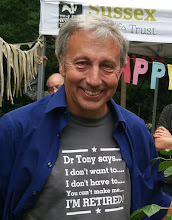There are two main processes shaping nature: succession, the
tendency to grow towards forest, going in one direction; and natural
disturbance working in the opposite direction.
The interaction between the two, at all scales and time-scales, creates
diversity in nature.
“Rewilding” could be seen as encouraging nature by re-asserting
these natural processes – allowing succession to progress alongside re-establishing
natural disturbance. An extra layer to
this is the restoration of the things that impact on natural disturbance. Predators, such as large carnivores, impact
on the numbers and behaviours of grazers, such as deer, and so in turn affect
natural disturbance.
Our landscape, however, is very far from natural. Humans have had a huge impact for thousands
of years, probably dating right back to the last ice age. Restoring wild nature, if it possible at all,
is certainly not possible everywhere.
Maybe there is another set of lessons we can learn from the 1987
storm – if natural disturbance is a good, indeed driving force in nature, can
disturbance from humans have a similar effect?
Think of the effects of the 1987 storm. Areas of woodland were blown flat; light then
got into the forest and there followed a burst of regeneration supporting a
range of different wildlife which changed as we went through the stages of regrowth. This created rich and diverse wildlife. With traditional forest management; an area
is cleared, light gets in and there follows a burst of regeneration. Pretty similar. There are differences but woodland management basically
does the same ecological job as natural disturbance.
One big difference to a wild past is that our forests are
but tiny fragments compared to the extensive natural habitat that would have clothed
our landscape. Natural disturbance,
however, often needs to work on a large scale.
For instance, 100 acres blown down in a natural forest covering many
thousands of acres is just one patch of disturbance. But in a modern landscape a 100 acre woodland
could all blow down at once. Woodland management,
however, effectively creates smaller patches of disturbance in our smaller
manged woods. A large scale disturbance
cycle has been replaced by a small scale disturbance cycle - a big natural
forest with big holes is replaced by a small managed forest with small holes. In
so doing a measure of diversity is retained.
Sympathetic woodland management in a small wood is probably more
natural than abandoning it. A small site does not have the scale for natural
processes to function whereas management (which you could consider “imposed”
disturbance) puts back a proxy for that natural disturbance.
This logic also extends to other forms of natural disturbance
and management. Large mammals would have
grazed a wild forest creating openings, maintaining a range of open habitats
like grassland and heathland. Abandonment
destroys those habitats but copying nature with domestic animals puts back the natural
process of grazing. Just adding grazers,
however, creates over-grazing, potentially reducing diversity not improving it. Predators would have made grazers move around
to avoid being eaten. Management of
domestic grazers by moving them around, avoiding over-grazing and creating
patches of different vegetation, can have a similar effect.
The analogies go on. Beavers
dig ditches and create wetlands – we dig ditches and create water meadows. Wild boar plough the ground and disturb the
soil – much of our management (such as extracting logs and ploughing fields)
disturbs the soil. Part of the fun of
ecology is seeing how nature functions for itself and then seeing whether there
is something in our management that does have, or could have a similar effect.

No comments:
Post a Comment